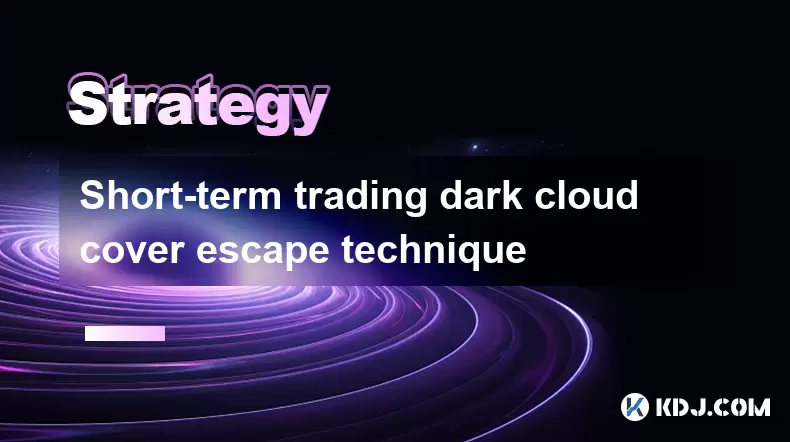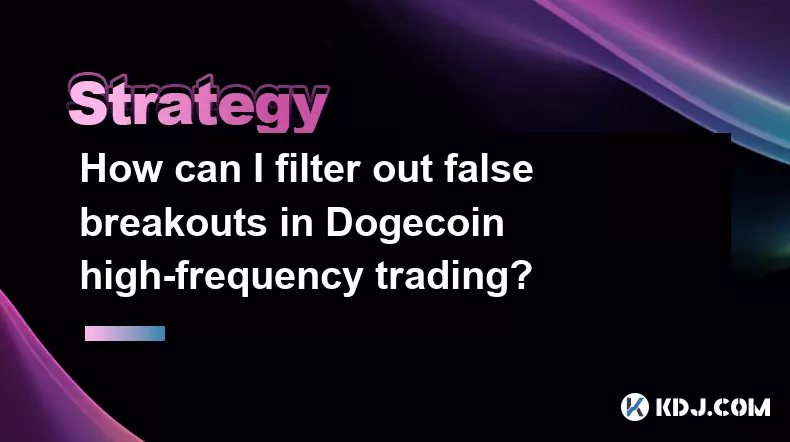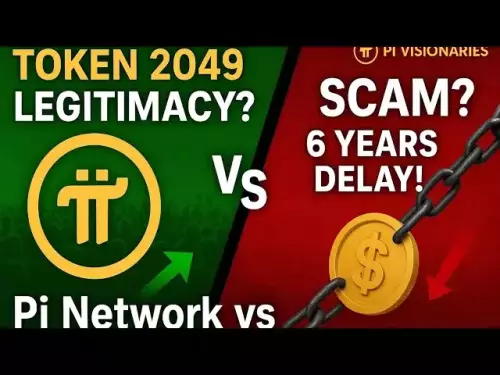-
 bitcoin
bitcoin $114779.865156 USD
2.30% -
 ethereum
ethereum $4226.519789 USD
2.39% -
 tether
tether $1.000545 USD
0.04% -
 xrp
xrp $2.890223 USD
0.92% -
 bnb
bnb $1030.029301 USD
2.95% -
 solana
solana $212.824944 USD
1.69% -
 usd-coin
usd-coin $0.999757 USD
0.01% -
 dogecoin
dogecoin $0.234961 USD
-0.27% -
 tron
tron $0.337174 USD
0.42% -
 cardano
cardano $0.804783 USD
0.09% -
 hyperliquid
hyperliquid $45.748770 USD
-2.85% -
 chainlink
chainlink $21.699170 USD
0.82% -
 ethena-usde
ethena-usde $1.001452 USD
0.08% -
 avalanche
avalanche $30.237800 USD
1.14% -
 stellar
stellar $0.372604 USD
1.52%
Short-term trading dark cloud cover escape technique
Dark Cloud Cover, a bearish reversal pattern, signals traders to exit long positions and enter shorts, using stop-losses and volume analysis for risk management.
Jun 13, 2025 at 06:00 pm

Introduction to Dark Cloud Cover
Dark Cloud Cover is a bearish reversal pattern that appears in an uptrend and signals a potential shift in market momentum. This pattern is formed over two candlesticks: the first is a bullish candlestick, followed by a bearish candlestick that opens above the high of the previous bullish candlestick but closes within the body of the first candlestick, ideally below its midpoint. Traders often use this pattern to identify potential entry points for short positions.
Understanding the Escape Technique
The escape technique for short-term trading involves recognizing the Dark Cloud Cover pattern and executing a strategic exit from a long position or entering a short position to capitalize on the expected downtrend. This technique requires a keen understanding of market sentiment and the ability to act swiftly on the identified signals.
Identifying the Dark Cloud Cover Pattern
To effectively apply the escape technique, traders must first accurately identify the Dark Cloud Cover pattern. Here are the steps to recognize this pattern:
- Observe the uptrend: Ensure that the market is in a clear uptrend, as the Dark Cloud Cover pattern is a reversal signal.
- Identify the first candlestick: Look for a strong bullish candlestick that confirms the continuation of the uptrend.
- Analyze the second candlestick: The next candlestick should open above the high of the previous bullish candlestick and close within its body, preferably below the midpoint.
Executing the Escape Technique
Once the Dark Cloud Cover pattern is identified, traders can execute the escape technique. Here's how to do it:
- Exit long positions: If you are currently holding a long position, consider closing it to avoid potential losses as the market may reverse.
- Enter short positions: Open a short position to capitalize on the expected downtrend. The entry point should be at or near the close of the bearish candlestick that forms the Dark Cloud Cover pattern.
- Set stop-loss orders: To manage risk, set a stop-loss order above the high of the bearish candlestick. This helps limit potential losses if the market does not reverse as expected.
- Monitor market conditions: Continuously monitor the market to adjust your strategy as needed. Look for additional confirmation signals such as increased trading volume or other bearish indicators.
Risk Management and Position Sizing
Effective risk management is crucial when employing the escape technique. Here are some strategies to consider:
- Position sizing: Determine the size of your position based on your risk tolerance and the potential impact of the trade on your portfolio. Smaller positions can help mitigate risk.
- Diversification: Avoid putting all your capital into a single trade. Diversify your investments to spread risk across different assets.
- Use of leverage: Be cautious with leverage, as it can amplify both gains and losses. Only use leverage if you fully understand the risks involved.
Technical Analysis Tools and Indicators
To enhance the effectiveness of the escape technique, traders can use various technical analysis tools and indicators. Some of these include:
- Moving Averages: Use moving averages to confirm the trend direction. A bearish crossover of short-term and long-term moving averages can reinforce the reversal signal provided by the Dark Cloud Cover pattern.
- Relative Strength Index (RSI): The RSI can help identify overbought conditions, which may precede a market reversal. A reading above 70 indicates overbought conditions, supporting the bearish signal from the Dark Cloud Cover.
- Volume Analysis: Increased trading volume during the formation of the Dark Cloud Cover pattern can provide additional confirmation of the bearish reversal.
Practical Example of the Escape Technique
To illustrate the escape technique, let's consider a hypothetical scenario:
- Market Context: Bitcoin (BTC) is in a strong uptrend, with prices consistently rising over the past month.
- Pattern Identification: On a particular day, a strong bullish candlestick forms, followed by a bearish candlestick that opens above the previous high but closes well within the body of the bullish candlestick, below its midpoint.
- Execution: Upon identifying the Dark Cloud Cover pattern, a trader decides to exit their long position in BTC and enters a short position at the close of the bearish candlestick. They set a stop-loss order just above the high of the bearish candlestick to manage risk.
- Outcome: Over the next few days, the price of BTC begins to decline, validating the bearish reversal signal. The trader monitors the market and adjusts their stop-loss order accordingly, eventually closing the short position for a profit.
Frequently Asked Questions
Q1: Can the Dark Cloud Cover pattern be used in other markets outside of cryptocurrency?Yes, the Dark Cloud Cover pattern is a versatile technical analysis tool that can be applied to various financial markets, including stocks, forex, and commodities. The principles of identifying and trading this pattern remain consistent across different markets.
Q2: How reliable is the Dark Cloud Cover pattern as a reversal signal?The reliability of the Dark Cloud Cover pattern can vary depending on market conditions and the timeframe used. While it is generally considered a strong bearish reversal signal, traders should always look for additional confirmation from other technical indicators and volume analysis to increase the probability of a successful trade.
Q3: What are some common mistakes traders make when using the escape technique?One common mistake is failing to set appropriate stop-loss orders, which can lead to significant losses if the market does not reverse as expected. Another mistake is over-relying on a single pattern without considering the broader market context and other technical indicators. Traders should also avoid entering positions too late, as the optimal entry point is often at the close of the bearish candlestick.
Q4: How can traders improve their ability to identify the Dark Cloud Cover pattern?Traders can improve their pattern recognition skills by practicing on historical charts and using demo accounts to test their strategies without risking real capital. Additionally, staying updated with market news and understanding the factors that influence price movements can help traders better anticipate potential reversals.
Disclaimer:info@kdj.com
The information provided is not trading advice. kdj.com does not assume any responsibility for any investments made based on the information provided in this article. Cryptocurrencies are highly volatile and it is highly recommended that you invest with caution after thorough research!
If you believe that the content used on this website infringes your copyright, please contact us immediately (info@kdj.com) and we will delete it promptly.
- Altcoins Primed for 100x Gains: Cryptocurrencies to Watch
- 2025-09-30 22:45:16
- Pi Network, OKX, and Withdrawal Woes: What's Going On?
- 2025-09-30 23:05:12
- Debut Auction & XRP ETF Watch: October 18th Auction Set, Crypto's Big Day?
- 2025-09-30 22:45:16
- Allbridge, Algorand, and Stablecoins: Bridging the Gap in DeFi
- 2025-09-30 23:05:12
- Navigating Solana Wallets: Your Guide to Secure Crypto in 2025
- 2025-09-30 22:50:11
- Shiba Inu's Uptober Rally: Will Exchange Supply Fuel the Fire?
- 2025-09-30 23:10:17
Related knowledge

Practical parameter settings for a Bitcoin multi-timeframe moving average system
Sep 18,2025 at 10:54pm
Optimizing Timeframe Combinations for Bitcoin Trading1. Selecting appropriate timeframes is crucial when building a multi-timeframe moving average sys...

How can I filter out false breakouts in Dogecoin high-frequency trading?
Sep 22,2025 at 01:00am
Understanding False Breakouts in Dogecoin Trading1. A false breakout occurs when Dogecoin's price appears to move beyond a defined support or resistan...

Techniques for identifying tops and bottoms in the Bitcoin on-chain NVT model
Sep 20,2025 at 07:54pm
Understanding the NVT Model in Bitcoin Analysis1. The Network Value to Transactions (NVT) ratio is often described as the 'P/E ratio' of the cryptocur...

What does the surge in open interest in Bitcoincoin futures mean?
Sep 20,2025 at 11:18pm
Understanding the Surge in Dogecoin Futures Open Interest1. A surge in open interest within Dogecoin futures indicates a growing number of active cont...

How can I use the Ethereum USDT premium to gauge market sentiment?
Sep 18,2025 at 11:55pm
Understanding the Ethereum USDT Premium1. The Ethereum USDT premium refers to the price difference between USDT (Tether) traded on Ethereum-based plat...

What should I do if Ethereum staking yields decline?
Sep 20,2025 at 06:18am
Understanding the Causes Behind Declining Ethereum Staking Yields1. The Ethereum network transitioned to a proof-of-stake consensus mechanism with the...

Practical parameter settings for a Bitcoin multi-timeframe moving average system
Sep 18,2025 at 10:54pm
Optimizing Timeframe Combinations for Bitcoin Trading1. Selecting appropriate timeframes is crucial when building a multi-timeframe moving average sys...

How can I filter out false breakouts in Dogecoin high-frequency trading?
Sep 22,2025 at 01:00am
Understanding False Breakouts in Dogecoin Trading1. A false breakout occurs when Dogecoin's price appears to move beyond a defined support or resistan...

Techniques for identifying tops and bottoms in the Bitcoin on-chain NVT model
Sep 20,2025 at 07:54pm
Understanding the NVT Model in Bitcoin Analysis1. The Network Value to Transactions (NVT) ratio is often described as the 'P/E ratio' of the cryptocur...

What does the surge in open interest in Bitcoincoin futures mean?
Sep 20,2025 at 11:18pm
Understanding the Surge in Dogecoin Futures Open Interest1. A surge in open interest within Dogecoin futures indicates a growing number of active cont...

How can I use the Ethereum USDT premium to gauge market sentiment?
Sep 18,2025 at 11:55pm
Understanding the Ethereum USDT Premium1. The Ethereum USDT premium refers to the price difference between USDT (Tether) traded on Ethereum-based plat...

What should I do if Ethereum staking yields decline?
Sep 20,2025 at 06:18am
Understanding the Causes Behind Declining Ethereum Staking Yields1. The Ethereum network transitioned to a proof-of-stake consensus mechanism with the...
See all articles










































































